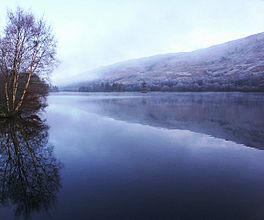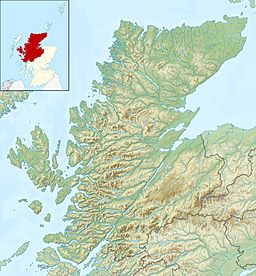Loch Oich facts for kids
Quick facts for kids Loch Oich |
|
|---|---|
 |
|
| Location | Highlands of Scotland |
| Coordinates | 57°4′N 4°47′W / 57.067°N 4.783°W |
| Type | freshwater loch |
| Basin countries | United Kingdom |
| Max. length | 6.5 km (4 mi) |
| Max. width | 1 km (0.62 mi) |
| Max. depth | 47 m (154 ft) |
| Surface elevation | 32 m (106 ft) |
Loch Oich (which means Loch Omhaich in Scottish Gaelic) is a beautiful loch in the Highlands of Scotland. A loch is the Scottish word for a lake. This freshwater loch is an important part of the Caledonian Canal, and it's actually the highest point along the entire canal!
This narrow loch is located in a famous valley called the Great Glen. It sits between two other well-known lochs: Loch Ness to the north-east and Loch Lochy to the south-west. Water flows into Loch Oich from the River Garry, which comes from Loch Garry in the west. From its northern end, Loch Oich feeds the River Oich. Special water gates called the Laggan locks connect Loch Oich to Loch Lochy.
Contents
Wildlife in Loch Oich
Loch Oich is home to many different kinds of animals. You can find a wide variety of fish, amphibians (like frogs), reptiles (like lizards), birds, and mammals living in and around the loch.
Every autumn, a special event happens: Atlantic salmon (whose scientific name is Salmo salar) travel from the sea. They use Loch Oich, Loch Lochy, and Loch Ness as safe places to lay their eggs. This journey is a vital part of their life cycle.
Building the Caledonian Canal
A long time ago, a famous engineer named Thomas Telford worked on the Caledonian Canal. To make sure boats could easily travel through Loch Oich, he made the loch deeper. He did this by raising the water level of the loch by many feet. This created a clear path for ships and boats to use as part of the canal.
The Well of the Seven Heads Monument
On the banks of Loch Oich, right next to the A82 road, stands a tall, needle-shaped monument. This monument was put there in 1812 by a person named Alexander Ranaldson Macdonell.
The monument was originally in a slightly different spot. In 1930, when the road was rebuilt, the monument was carefully moved a few yards from its first location. It stands there today as a historical landmark.
See also
 In Spanish: Lago Oich para niños
In Spanish: Lago Oich para niños


